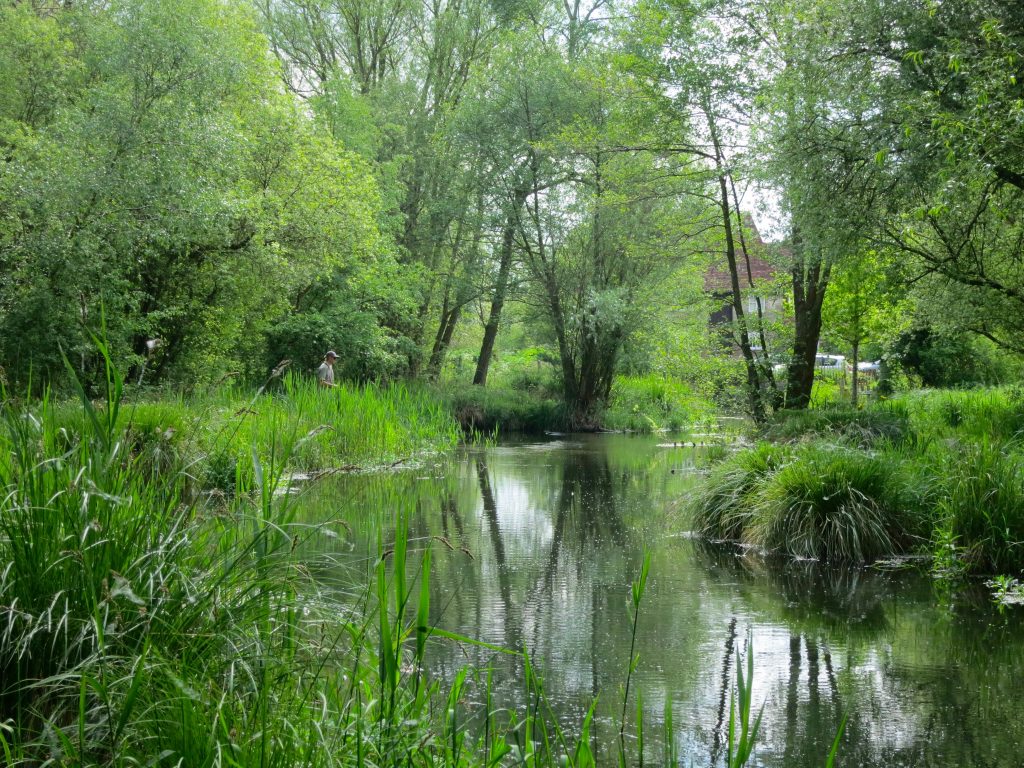Salmon & Trout Conservation has undertaken a three-year Riverfly Census on the Whitewater. Their analysis S&TC Whitewater Conclusions final has revealed that the river is in ecological crisis. The River Whitewater is a chalkstream, one of only about 200 in the world. The most significant water quality pressures are sediment, nutrient and chemical pressure.
The River Whitewater is currently failing to meet Good Ecological Status as required under the Water Framework Directive. The main pressures and reason for failure are physical habitat and barriers to fish passage. This means fish populations are prevented from moving freely through the river. Such barriers include mills, weirs and culverts. Physical barriers also impede sediment movement. They change flow, which can promote build up of fine silts. Such accumulation alters the natural river form which can impact the ecological status. Our survey shows evidence of this, with persistent sediment stress being indicated by the invertebrate community.
Land use surrounding the Whitewater shifts from predominantly arable to grassland along the river. Arable farming, especially when it is undertaken right up to the river’s edge, can contribute high quantities of excess fine sediment to a watercourse. Crop harvesting and ploughing leaves soil bare and vulnerable to washing off during rain events. Water friendly farming techniques such as cover crops, buffer strips and zero tillage (where feasible) would benefit the upper reaches of the Whitewater by reducing the sediment load.
Many chemicals, such as pesticides and herbicides used in arable agriculture, bind soil and are delivered to watercourses via sediment run-off. Chemical stress was indicated at nearly all sites. A seasonal chemical impact was exhibited by the invertebrate community. All failures of the proposed Water Framework Directive Species At Risk (SPEAR) standard for chemicals occurred in autumn.
Burrowing from signal crayfish can increase bank erosion and introduce greater sediment loads into the river. Therefore, it is important not to overlook this as a contributing factor to sediment stress in the Whitewater. Invasive North American signal crayfish (Pacifastacus leniusculus) were detected at all of the sites monitored in the Whitewater survey. These crayfish are capable of exerting change in ecological condition to the river both directly, through disease, predation, competition or displacement, and indirectly by disrupting food chain dynamics and altering physical and chemical habitat characteristics.
In 1981 mass mortality of the native white-clawed crayfish (Austropotamobius pallipes) was observed and following this, the species completely disappeared from the Whitewater and Loddon rivers. Crayfish plague, of which signals are carriers, is suspected as the cause but this is unconfirmed. Signal crayfish are found most frequently at Hook Mill. Juvenile signal crayfish recruitment was particularly high at Poland Mill in spring 2019. A lack of leeches and molluscs found at these sites infers an ecosystem impact from signal crayfish predation.
Taking appropriate measures to reduce the signal crayfish population may benefit the Whitewater’s ecology. Activities such as trapping will not eradicate populations of signal crayfish, but in some cases can increase the total number of individual macroinvertebrates.
Nutrient stress was less pronounced than sediment stress in the Whitewater at our surveyed sites, but was still indicated as moderate on many occasions. Excess phosphate entering the Whitewater is likely to be from a combination of sources, including runoff from arable agriculture and wastewater discharges.
The Odiham sewerage drainage area is served by the North Warnborough Sewage Pumping Station. This pumping station is reported to fail most years for a variety of reasons, including blockages, misconnections and groundwater ingress. Failure often results in the discharge of raw sewage directly into the Whitewater. Although our methodology evaluates longer term invertebrate community responses and not the biological impact of specific gross pollution incidents such as this, the failings of this system may have increased consequences for water quality in the future.
Applications for new housing developments in Odiham and North Warnborough have recently been made, but if developments were to go ahead, the sewerage demand in the area would increase. For any future development, it is essential that the sewerage infrastructure is sufficient to protect the environment. Thames Water stated that capacity to accommodate significant growth was not available in the North Warnborough area and that upgrades to the network should be anticipated.
Further investigations are being made to find out whether any improvements have been made at the North Warnborough SPS, as part of the most recent Asset Management Plan cycle.
During the survey two caseless caddis species relatively rare to the Whitewater system (according to historical Environment Agency records) were found. These were Metalype fragilis, found at Poland Mill and Polycentropus irroratus, found at Holdshott Farm.


I am a resident of Upton Grey, your comments about the housing developments are worrying with the impact on the Odiham sewage station and the Whitewater river. UG is a tiny village of 609 residents but even here in the last year there has been a development of 20 houses, and we are currently fighting to stop three further developments with a total of 25 more dwellings, our village infrastructure is not up to this increase level in sewage, and currently as I write this, the developers are struggling to connect to the main sewers. When they eventually complete this it will put extra pressure on the Odiham sewage works, which is obviously already inadequate for the levels of sewage.